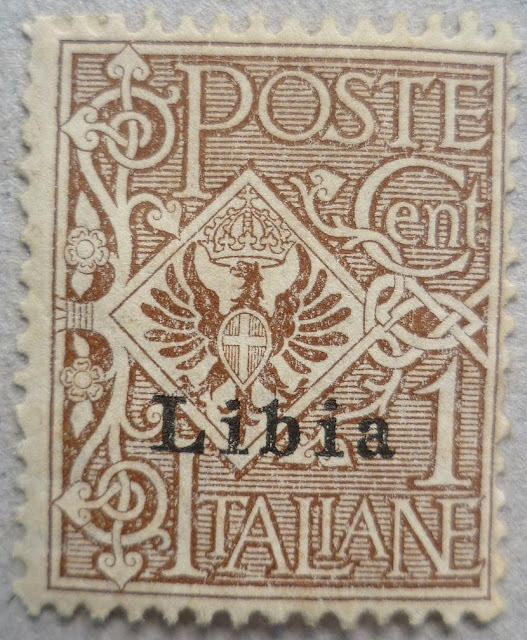"The Stamp Collectors Stockbook": Page 4
From the Estate of Grandpa5000
Page four:
A quick look in a stamp catalog would tell me what personage is featured on this old 100 ("cem") Reis stamp from the United States of Brazil. Isn't she cute, though?
This French stamp looks much, much newer than most of the stuff on this page. But I like it for the dreamy rendering of the canyon landscape. It looks ever so slightly Chinese.
It's the Queen! Not Elizabeth, it's Queen Victoria, in this stamp from the island country of St. Lucia issued almost a century before it would actually become an independent country. What circumstances led someone to thickly pencil in the very specific "3.998" over the stamp, I do not know how to reconstruct from the available evidence. And yet it was probably some kind of commonplace, even routine act, by someone who job it was to, among other things, indicate specific quantities on postage stamps. It was a technical, competent act performed by someone in possession of an entire, rich life of hopes, plans, secrets, and fears. And now he or she,is gone, and the stamp still remains, still carrying the arcane information embedded within the "3.998" unusefully into the future.
Italy claimed Libya as a colony after the Italo-Turkish War of 1911-1912, of which you have never heard until this very day. Three very bad decades followed. After World War II, Libya would continue to have a troubled history, but with Italy inflicting considerably less of the trouble. In 2008, Italy said it was sorry -- one of those international gestures that I find both preposterously inadequate and extremely encouraging.
The word "Köztársaság" has a rather alarming look to it for an English speaker, especially when it is aggressively emblazoned diagonally and in all caps across a nice blue postage stamp. It turns out that it is the Hungarian (if there's one thing every child with a stamp collection knows, it's that "Magyar" is (basically) Hungarian for "Hungarian") word for.... "republic."
The overprint puts this stamp in the narrow window of Nov 8, 1918 to March 21, 1919. As the First World War ground down, the Austro-Hungarian Empire disintegrated. Hungary (which had been printing its own postage stamps for a long time) went through one of those turbulent times one hopes not to see in one's own country and lifetime: a constitutional democracy was overthrown by a heavy-handed Communist regime which deliberately fostered hyperinflation; then, after a Romanian invasion, an "ultraconservative" government was put in charge, and then there was some guerrilla war as new borders were sorted out, and, well... nobody was having much of a good time. The "REPUBLIC" stamps were from the constitutional democracy, so this little tag of paper is emblematic of the short, sweet burst of optimism when people could hope that the "war to end all wars" had just maybe worked.
--
But what have we here? Diez Centavos from "Franqueo"? This is, I think, a stamp my grandfather brought back from an alternative reality in which Imperial Spain made better use of its vast, vast imports of stolen gold and was able to subdue and culturally subjugate its northern neighbor. But this is just a hypothesis. Hang on while I make use of the internet.
No, I'm an idiot. Franqueo is Spanish for "postage." And looking more carefully, I can see what is probably "Peru" both obscured by, and within, the very heavy cancellation.
Well, there are still mysteries. Here are two puzzles for the linguistic, heraldic, and/or philatelic dorks among you (who rose to the bait rather handsomely, I must say, last time around):
1. Where? And celebrating 100 years of what?
And, what unhelpful nation printed THIS orange beauty?
Only one page left!













5 comments:
The St. Lucia stamp looks to me like it has written on it 3.9.98, and then some initials below it. Could it have been some sort of hand cancellation? Maybe the postal clerk had misplaced his cancellation stamper and had to revert to a "pen cancel": http://en.wikipedia.org/wiki/Pen_cancel
It's the date! Ben, you may move to the front of the class.
Meanwhile, I've realized that the Peru(?) stamp doesn't have a heavy cancellation, but somebody's portrait actually overprinted over whatever the stamp originally shown. Somebody with a pretty big ego, you'd have to think.
Your mystery Stamp is Serbian. Here is a description/explanation, as given in "The Postage Stamp in War" by Fred. J. Melville (1915) -
The Coronation stamps of King Peter, issued September 21, 1904, are of large size, and in two designs, by G. Janovic. M. Mouchon was the engraver, and the stamps were printed at the French Government Stamp Printing Factory in Paris. The names of the designer and engraver appear in microscopic letters below the design of each stamp. The first design (_Fig._ 223) shows a medal on which the profile of the new King Peter is superimposed upon the profile of the founder of the dynasty "Kara," or Black George. The names inscribed upon the medal are KARA GJORGJE at left, and PETAR I. at right. To the left and right of the medal respectively are the centennial dates 1804-1904, and below are the Serbian Arms, with the motto SPES MIHI PRIMA DEUS. Along the top of the stamp in Sclavonic characters is KRALJEVINA SRBIJA (Kingdom of Servia), the value in PARA is in the lower left corner, and the word POSHTA in the lower right corner. This design was used for all the para values.
Those are doozies. I like the "Libia" one.
lamanyana, I have to salute a man who keeps a copy of Melville within arm's reach.
Post a Comment